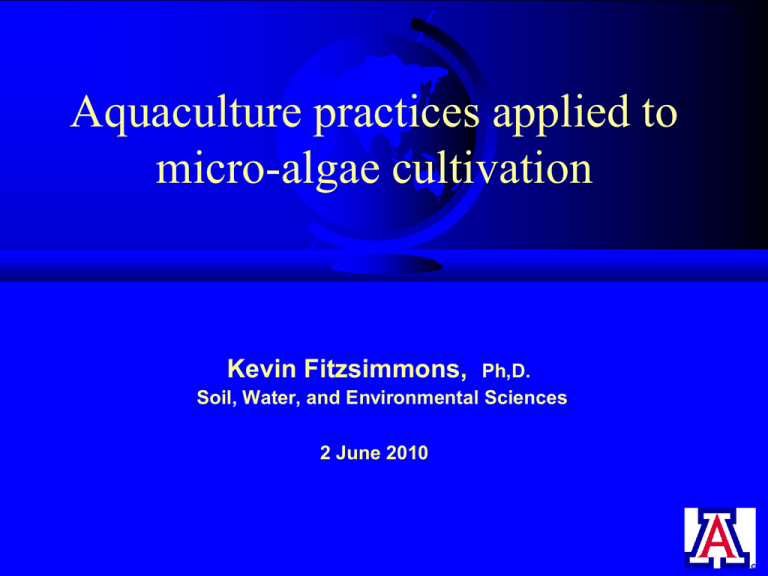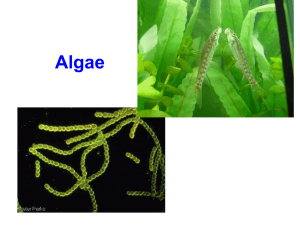AlgaeUnivAZ_Fitz_Biofuels
advertisement

Aquaculture practices applied to micro-algae cultivation Kevin Fitzsimmons, Ph,D. Soil, Water, and Environmental Sciences 2 June 2010 Algae Aquaculture Algae represent the largest aquaculture crop on global basis Algae are a major component of diet in Asia and Pacific cuisine Algae are a growing sector for niche markets in the US Aquaculture producers know how to manage algae Fish, shrimp, and bivalve farmers deal with algae blooms on daily basis They are experts on water management and removing small living things from water They have large amounts of nutrient rich water and facilities for holding water Algae by-products are valuable feed ingredients UA algae farming- Moloka’i Shrimp/fish and edible seaweeds Gracilaria being washed in cage Data report - Daily growth rates of % growth per day Gracilaria with shrimp effluent over 4 weeks 10 9 8 7 6 5 4 3 2 1 0 In effluent channel Transferred to ocean Chemical fertilizer Not fertilzed Demonstration ponds stocked with Gracilaria & Eucheuma as part of aquaculture restoration post-tsunami KAB. ACEH PIDIE (5.073) Ha Aceh Besar KAB. ACEH BESAR (3.450) Ha KAB. BIREUN(6.710) Ha Initial stocks from Ohama corporate farm (1000 kg) brought to Sumatra Material loaded from farm Fresh material Gracilaria distributed into ponds Workshops and training Field visits to farmers Shrimp - fish - seaweeds Fish cage effluents (feed and feces) fertilize seaweed Fresh Gracilaria from the shrimp pond PLANTING OF SEAWEED (Eucheuma SEED GROWOUT OF Eucheuma SEAWEED SEAWEED IS READY FOR HARVEST SEAWEED HARVESTING Results Seaweed, milkfish and shrimp polyculture Saudi Arabia project Integrated fish and shrimp effluent to fertilize algae Lab culture of micro and macro algae Bioreactor and raceway production Off to the next workshop ……… Micro-algae aquaculture Commonly used for larval fish, shrimp, and bivalves Some for human consumption Spirulina, Super blue-green algae, etc. Most US microalgae culture is in the Western Region (California, Oregon, Washington) Blue-greens or Cyanophytes Most commonly farmed cyanobacteria is Spirulina Spirulina was collected naturally from Lake Texcoco by the Aztec and by natives around Lake Chad in central Africa Spirulina has now become a major product in the health food market, farms in California Micro-algae culture with China Academy of Sciences, Beijing Harvesting Rotating screen filters Water passes through, how much algae can be caught in: 60 µm screen? 20 µm screen? 5 µm screen? Integrated Pest Management First ARID trials Diatoms first fouling organisms Grazing protozoan second organism Need to develop IPM plan similar to those developed for hydroponics and field crops By-product uses Aquaculture feeds Sources of beta-carotene, astaxanthin, canthaxanthin, and other carotenoids







